NURBN2009: Health Promotion Program Planning and Evaluation Report
VerifiedAdded on 2022/09/22
|9
|1954
|24
Report
AI Summary
This report presents a comprehensive health promotion program designed to address mental illness among Australian youth aged 20-35 in Melbourne. The program utilizes Cognitive Behavioral Therapy (CBT) with a SMART goal to reduce anxiety and depression levels by 50% in 500 participants. It outlines measurable objectives, including the use of the Beck Depression Inventory, and detailed activities such as recruitment, questionnaire re-examination, and CBT modules. The program's timeline spans 12 weeks with 16 sessions, acknowledging potential challenges like participant unwillingness and questionnaire biases. The evaluation section details outcome, impact, and process evaluation methods, including the use of the Beck Depression Inventory and observational assessments. The report emphasizes the importance of continuous reflection and the use of formal and informal tools to measure the program's success and impact on the target population, referencing relevant literature to support the methodologies used.
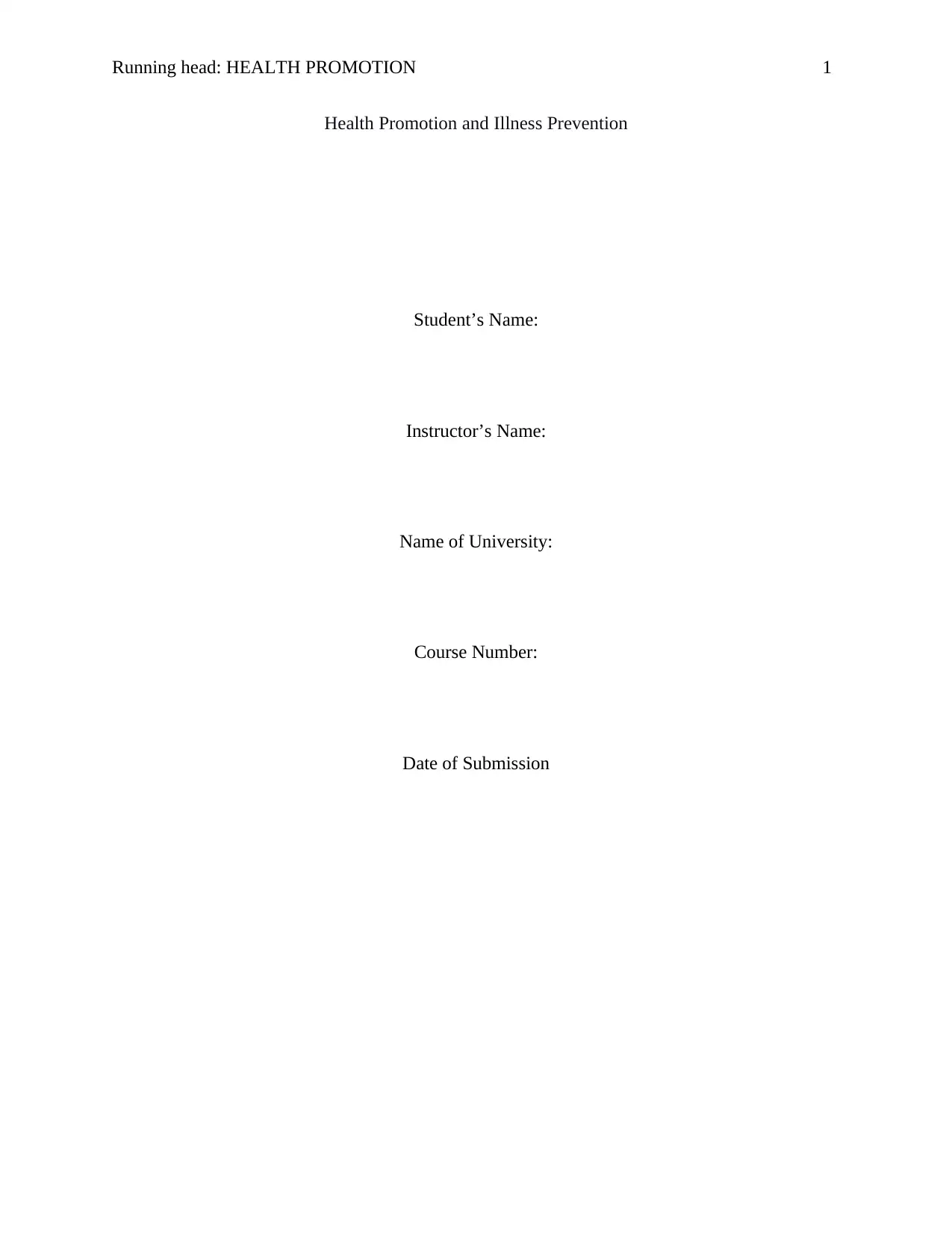
Running head: HEALTH PROMOTION 1
Health Promotion and Illness Prevention
Student’s Name:
Instructor’s Name:
Name of University:
Course Number:
Date of Submission
Health Promotion and Illness Prevention
Student’s Name:
Instructor’s Name:
Name of University:
Course Number:
Date of Submission
Paraphrase This Document
Need a fresh take? Get an instant paraphrase of this document with our AI Paraphraser
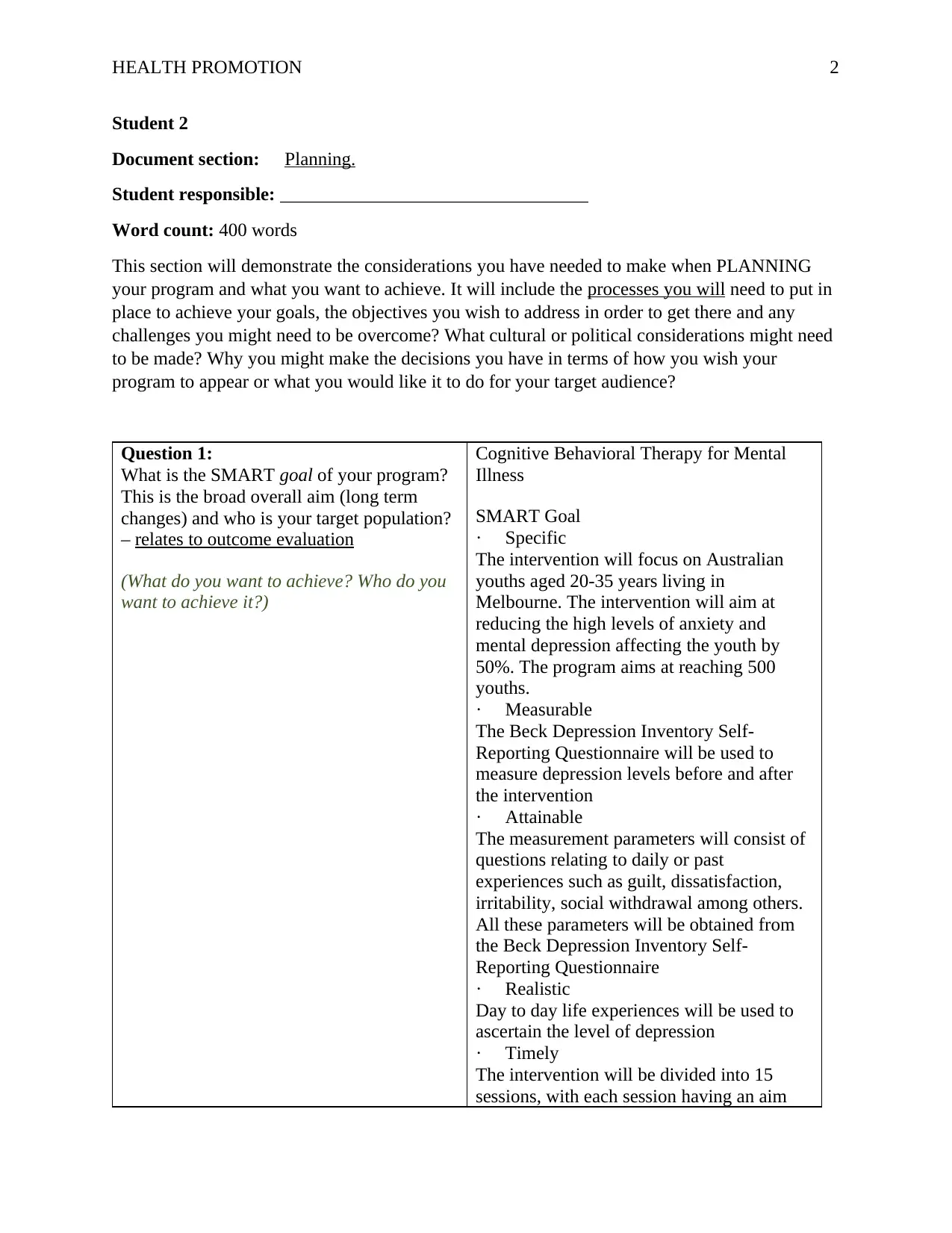
HEALTH PROMOTION 2
Student 2
Document section: Planning.
Student responsible: _________________________________
Word count: 400 words
This section will demonstrate the considerations you have needed to make when PLANNING
your program and what you want to achieve. It will include the processes you will need to put in
place to achieve your goals, the objectives you wish to address in order to get there and any
challenges you might need to be overcome? What cultural or political considerations might need
to be made? Why you might make the decisions you have in terms of how you wish your
program to appear or what you would like it to do for your target audience?
Question 1:
What is the SMART goal of your program?
This is the broad overall aim (long term
changes) and who is your target population?
– relates to outcome evaluation
(What do you want to achieve? Who do you
want to achieve it?)
Cognitive Behavioral Therapy for Mental
Illness
SMART Goal
· Specific
The intervention will focus on Australian
youths aged 20-35 years living in
Melbourne. The intervention will aim at
reducing the high levels of anxiety and
mental depression affecting the youth by
50%. The program aims at reaching 500
youths.
· Measurable
The Beck Depression Inventory Self-
Reporting Questionnaire will be used to
measure depression levels before and after
the intervention
· Attainable
The measurement parameters will consist of
questions relating to daily or past
experiences such as guilt, dissatisfaction,
irritability, social withdrawal among others.
All these parameters will be obtained from
the Beck Depression Inventory Self-
Reporting Questionnaire
· Realistic
Day to day life experiences will be used to
ascertain the level of depression
· Timely
The intervention will be divided into 15
sessions, with each session having an aim
Student 2
Document section: Planning.
Student responsible: _________________________________
Word count: 400 words
This section will demonstrate the considerations you have needed to make when PLANNING
your program and what you want to achieve. It will include the processes you will need to put in
place to achieve your goals, the objectives you wish to address in order to get there and any
challenges you might need to be overcome? What cultural or political considerations might need
to be made? Why you might make the decisions you have in terms of how you wish your
program to appear or what you would like it to do for your target audience?
Question 1:
What is the SMART goal of your program?
This is the broad overall aim (long term
changes) and who is your target population?
– relates to outcome evaluation
(What do you want to achieve? Who do you
want to achieve it?)
Cognitive Behavioral Therapy for Mental
Illness
SMART Goal
· Specific
The intervention will focus on Australian
youths aged 20-35 years living in
Melbourne. The intervention will aim at
reducing the high levels of anxiety and
mental depression affecting the youth by
50%. The program aims at reaching 500
youths.
· Measurable
The Beck Depression Inventory Self-
Reporting Questionnaire will be used to
measure depression levels before and after
the intervention
· Attainable
The measurement parameters will consist of
questions relating to daily or past
experiences such as guilt, dissatisfaction,
irritability, social withdrawal among others.
All these parameters will be obtained from
the Beck Depression Inventory Self-
Reporting Questionnaire
· Realistic
Day to day life experiences will be used to
ascertain the level of depression
· Timely
The intervention will be divided into 15
sessions, with each session having an aim
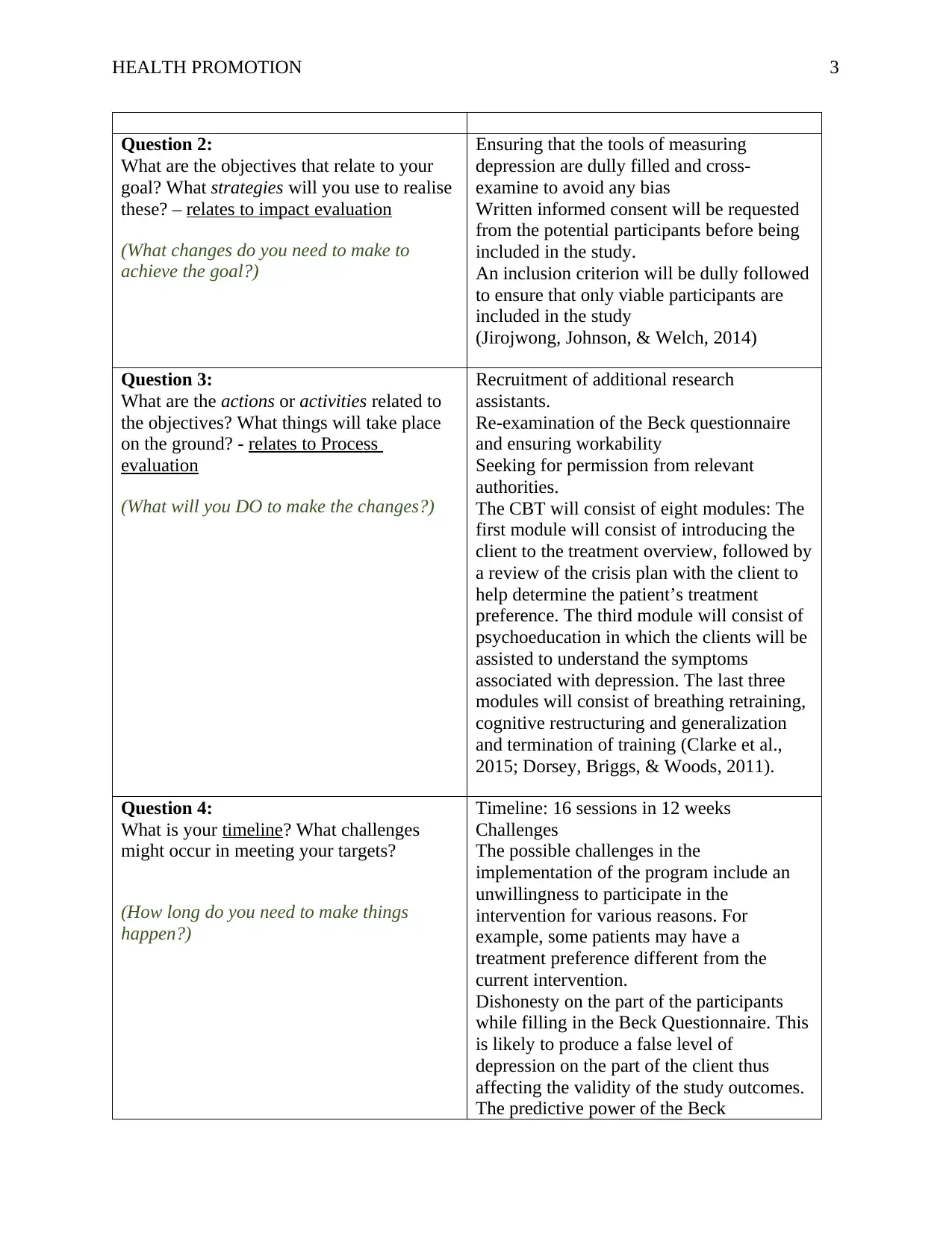
HEALTH PROMOTION 3
Question 2:
What are the objectives that relate to your
goal? What strategies will you use to realise
these? – relates to impact evaluation
(What changes do you need to make to
achieve the goal?)
Ensuring that the tools of measuring
depression are dully filled and cross-
examine to avoid any bias
Written informed consent will be requested
from the potential participants before being
included in the study.
An inclusion criterion will be dully followed
to ensure that only viable participants are
included in the study
(Jirojwong, Johnson, & Welch, 2014)
Question 3:
What are the actions or activities related to
the objectives? What things will take place
on the ground? - relates to Process
evaluation
(What will you DO to make the changes?)
Recruitment of additional research
assistants.
Re-examination of the Beck questionnaire
and ensuring workability
Seeking for permission from relevant
authorities.
The CBT will consist of eight modules: The
first module will consist of introducing the
client to the treatment overview, followed by
a review of the crisis plan with the client to
help determine the patient’s treatment
preference. The third module will consist of
psychoeducation in which the clients will be
assisted to understand the symptoms
associated with depression. The last three
modules will consist of breathing retraining,
cognitive restructuring and generalization
and termination of training (Clarke et al.,
2015; Dorsey, Briggs, & Woods, 2011).
Question 4:
What is your timeline? What challenges
might occur in meeting your targets?
(How long do you need to make things
happen?)
Timeline: 16 sessions in 12 weeks
Challenges
The possible challenges in the
implementation of the program include an
unwillingness to participate in the
intervention for various reasons. For
example, some patients may have a
treatment preference different from the
current intervention.
Dishonesty on the part of the participants
while filling in the Beck Questionnaire. This
is likely to produce a false level of
depression on the part of the client thus
affecting the validity of the study outcomes.
The predictive power of the Beck
Question 2:
What are the objectives that relate to your
goal? What strategies will you use to realise
these? – relates to impact evaluation
(What changes do you need to make to
achieve the goal?)
Ensuring that the tools of measuring
depression are dully filled and cross-
examine to avoid any bias
Written informed consent will be requested
from the potential participants before being
included in the study.
An inclusion criterion will be dully followed
to ensure that only viable participants are
included in the study
(Jirojwong, Johnson, & Welch, 2014)
Question 3:
What are the actions or activities related to
the objectives? What things will take place
on the ground? - relates to Process
evaluation
(What will you DO to make the changes?)
Recruitment of additional research
assistants.
Re-examination of the Beck questionnaire
and ensuring workability
Seeking for permission from relevant
authorities.
The CBT will consist of eight modules: The
first module will consist of introducing the
client to the treatment overview, followed by
a review of the crisis plan with the client to
help determine the patient’s treatment
preference. The third module will consist of
psychoeducation in which the clients will be
assisted to understand the symptoms
associated with depression. The last three
modules will consist of breathing retraining,
cognitive restructuring and generalization
and termination of training (Clarke et al.,
2015; Dorsey, Briggs, & Woods, 2011).
Question 4:
What is your timeline? What challenges
might occur in meeting your targets?
(How long do you need to make things
happen?)
Timeline: 16 sessions in 12 weeks
Challenges
The possible challenges in the
implementation of the program include an
unwillingness to participate in the
intervention for various reasons. For
example, some patients may have a
treatment preference different from the
current intervention.
Dishonesty on the part of the participants
while filling in the Beck Questionnaire. This
is likely to produce a false level of
depression on the part of the client thus
affecting the validity of the study outcomes.
The predictive power of the Beck
⊘ This is a preview!⊘
Do you want full access?
Subscribe today to unlock all pages.

Trusted by 1+ million students worldwide
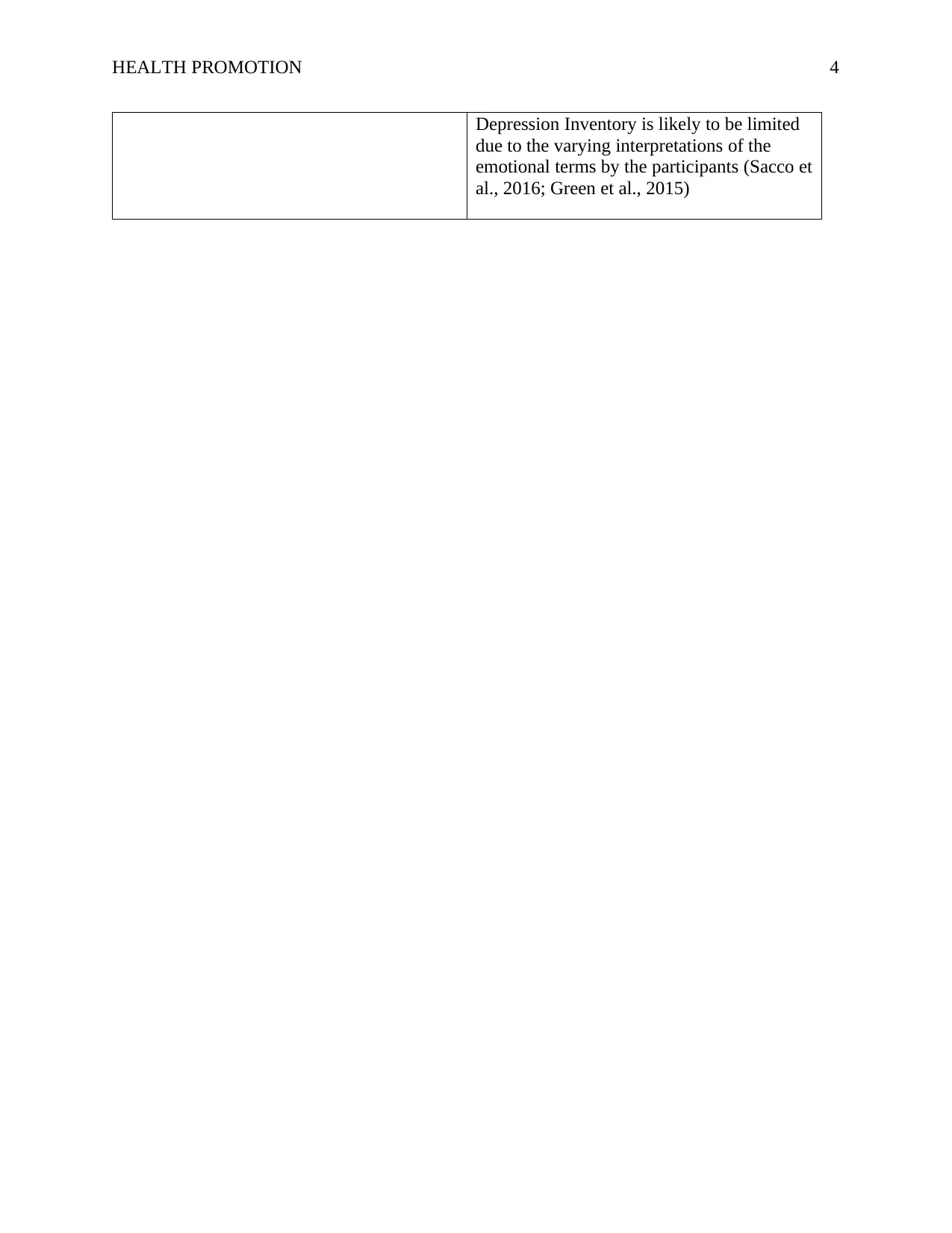
HEALTH PROMOTION 4
Depression Inventory is likely to be limited
due to the varying interpretations of the
emotional terms by the participants (Sacco et
al., 2016; Green et al., 2015)
Depression Inventory is likely to be limited
due to the varying interpretations of the
emotional terms by the participants (Sacco et
al., 2016; Green et al., 2015)
Paraphrase This Document
Need a fresh take? Get an instant paraphrase of this document with our AI Paraphraser
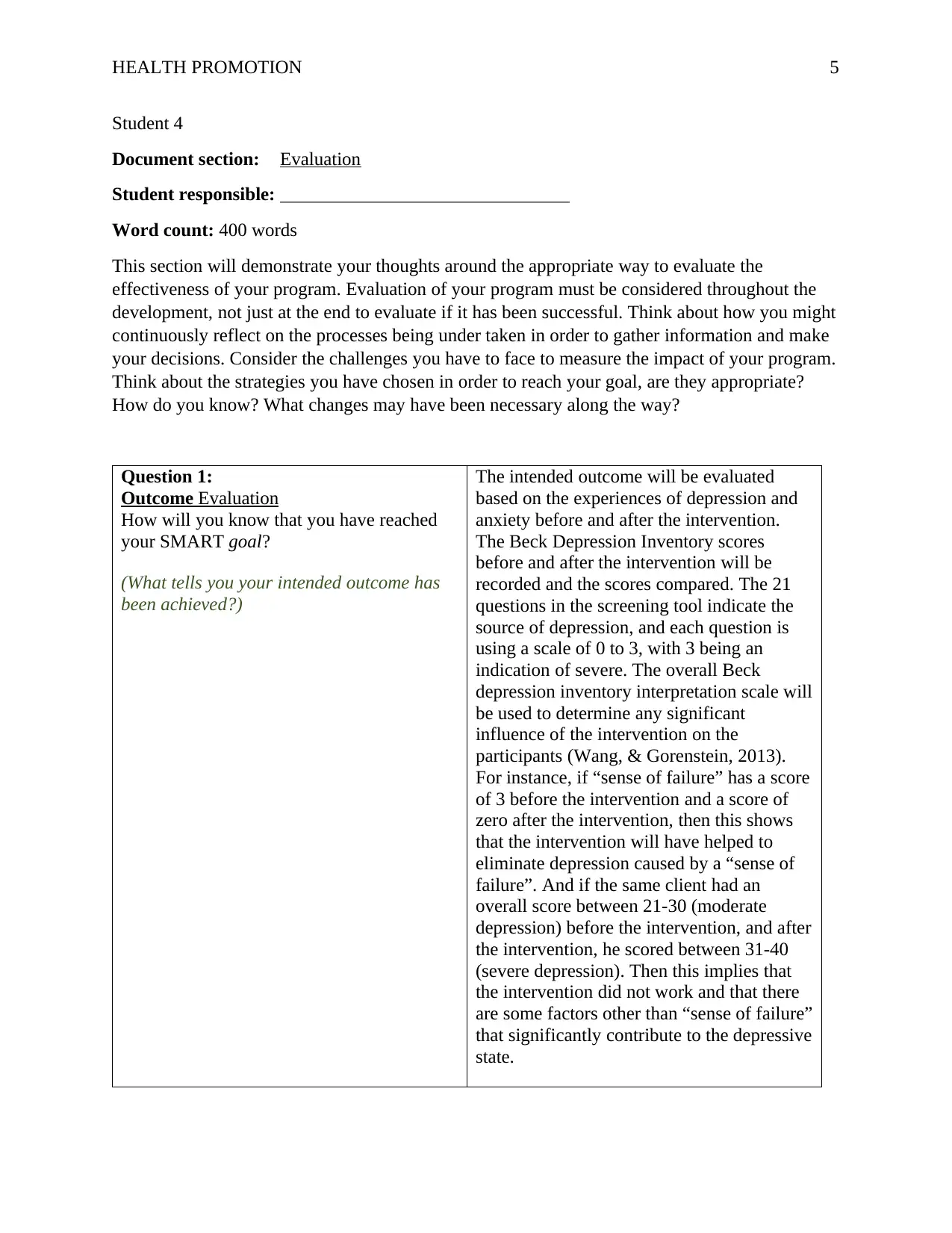
HEALTH PROMOTION 5
Student 4
Document section: Evaluation
Student responsible: _______________________________
Word count: 400 words
This section will demonstrate your thoughts around the appropriate way to evaluate the
effectiveness of your program. Evaluation of your program must be considered throughout the
development, not just at the end to evaluate if it has been successful. Think about how you might
continuously reflect on the processes being under taken in order to gather information and make
your decisions. Consider the challenges you have to face to measure the impact of your program.
Think about the strategies you have chosen in order to reach your goal, are they appropriate?
How do you know? What changes may have been necessary along the way?
Question 1:
Outcome Evaluation
How will you know that you have reached
your SMART goal?
(What tells you your intended outcome has
been achieved?)
The intended outcome will be evaluated
based on the experiences of depression and
anxiety before and after the intervention.
The Beck Depression Inventory scores
before and after the intervention will be
recorded and the scores compared. The 21
questions in the screening tool indicate the
source of depression, and each question is
using a scale of 0 to 3, with 3 being an
indication of severe. The overall Beck
depression inventory interpretation scale will
be used to determine any significant
influence of the intervention on the
participants (Wang, & Gorenstein, 2013).
For instance, if “sense of failure” has a score
of 3 before the intervention and a score of
zero after the intervention, then this shows
that the intervention will have helped to
eliminate depression caused by a “sense of
failure”. And if the same client had an
overall score between 21-30 (moderate
depression) before the intervention, and after
the intervention, he scored between 31-40
(severe depression). Then this implies that
the intervention did not work and that there
are some factors other than “sense of failure”
that significantly contribute to the depressive
state.
Student 4
Document section: Evaluation
Student responsible: _______________________________
Word count: 400 words
This section will demonstrate your thoughts around the appropriate way to evaluate the
effectiveness of your program. Evaluation of your program must be considered throughout the
development, not just at the end to evaluate if it has been successful. Think about how you might
continuously reflect on the processes being under taken in order to gather information and make
your decisions. Consider the challenges you have to face to measure the impact of your program.
Think about the strategies you have chosen in order to reach your goal, are they appropriate?
How do you know? What changes may have been necessary along the way?
Question 1:
Outcome Evaluation
How will you know that you have reached
your SMART goal?
(What tells you your intended outcome has
been achieved?)
The intended outcome will be evaluated
based on the experiences of depression and
anxiety before and after the intervention.
The Beck Depression Inventory scores
before and after the intervention will be
recorded and the scores compared. The 21
questions in the screening tool indicate the
source of depression, and each question is
using a scale of 0 to 3, with 3 being an
indication of severe. The overall Beck
depression inventory interpretation scale will
be used to determine any significant
influence of the intervention on the
participants (Wang, & Gorenstein, 2013).
For instance, if “sense of failure” has a score
of 3 before the intervention and a score of
zero after the intervention, then this shows
that the intervention will have helped to
eliminate depression caused by a “sense of
failure”. And if the same client had an
overall score between 21-30 (moderate
depression) before the intervention, and after
the intervention, he scored between 31-40
(severe depression). Then this implies that
the intervention did not work and that there
are some factors other than “sense of failure”
that significantly contribute to the depressive
state.
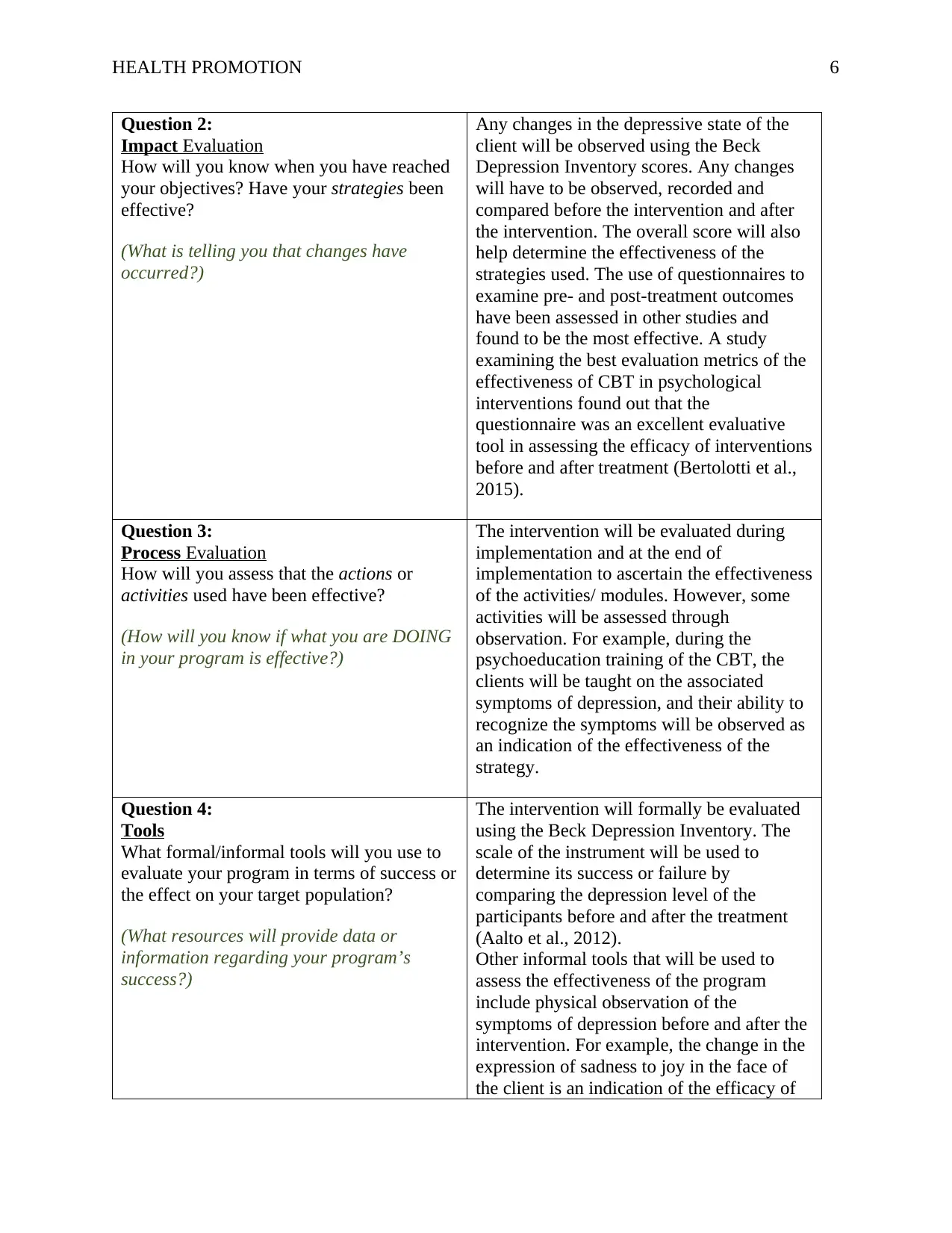
HEALTH PROMOTION 6
Question 2:
Impact Evaluation
How will you know when you have reached
your objectives? Have your strategies been
effective?
(What is telling you that changes have
occurred?)
Any changes in the depressive state of the
client will be observed using the Beck
Depression Inventory scores. Any changes
will have to be observed, recorded and
compared before the intervention and after
the intervention. The overall score will also
help determine the effectiveness of the
strategies used. The use of questionnaires to
examine pre- and post-treatment outcomes
have been assessed in other studies and
found to be the most effective. A study
examining the best evaluation metrics of the
effectiveness of CBT in psychological
interventions found out that the
questionnaire was an excellent evaluative
tool in assessing the efficacy of interventions
before and after treatment (Bertolotti et al.,
2015).
Question 3:
Process Evaluation
How will you assess that the actions or
activities used have been effective?
(How will you know if what you are DOING
in your program is effective?)
The intervention will be evaluated during
implementation and at the end of
implementation to ascertain the effectiveness
of the activities/ modules. However, some
activities will be assessed through
observation. For example, during the
psychoeducation training of the CBT, the
clients will be taught on the associated
symptoms of depression, and their ability to
recognize the symptoms will be observed as
an indication of the effectiveness of the
strategy.
Question 4:
Tools
What formal/informal tools will you use to
evaluate your program in terms of success or
the effect on your target population?
(What resources will provide data or
information regarding your program’s
success?)
The intervention will formally be evaluated
using the Beck Depression Inventory. The
scale of the instrument will be used to
determine its success or failure by
comparing the depression level of the
participants before and after the treatment
(Aalto et al., 2012).
Other informal tools that will be used to
assess the effectiveness of the program
include physical observation of the
symptoms of depression before and after the
intervention. For example, the change in the
expression of sadness to joy in the face of
the client is an indication of the efficacy of
Question 2:
Impact Evaluation
How will you know when you have reached
your objectives? Have your strategies been
effective?
(What is telling you that changes have
occurred?)
Any changes in the depressive state of the
client will be observed using the Beck
Depression Inventory scores. Any changes
will have to be observed, recorded and
compared before the intervention and after
the intervention. The overall score will also
help determine the effectiveness of the
strategies used. The use of questionnaires to
examine pre- and post-treatment outcomes
have been assessed in other studies and
found to be the most effective. A study
examining the best evaluation metrics of the
effectiveness of CBT in psychological
interventions found out that the
questionnaire was an excellent evaluative
tool in assessing the efficacy of interventions
before and after treatment (Bertolotti et al.,
2015).
Question 3:
Process Evaluation
How will you assess that the actions or
activities used have been effective?
(How will you know if what you are DOING
in your program is effective?)
The intervention will be evaluated during
implementation and at the end of
implementation to ascertain the effectiveness
of the activities/ modules. However, some
activities will be assessed through
observation. For example, during the
psychoeducation training of the CBT, the
clients will be taught on the associated
symptoms of depression, and their ability to
recognize the symptoms will be observed as
an indication of the effectiveness of the
strategy.
Question 4:
Tools
What formal/informal tools will you use to
evaluate your program in terms of success or
the effect on your target population?
(What resources will provide data or
information regarding your program’s
success?)
The intervention will formally be evaluated
using the Beck Depression Inventory. The
scale of the instrument will be used to
determine its success or failure by
comparing the depression level of the
participants before and after the treatment
(Aalto et al., 2012).
Other informal tools that will be used to
assess the effectiveness of the program
include physical observation of the
symptoms of depression before and after the
intervention. For example, the change in the
expression of sadness to joy in the face of
the client is an indication of the efficacy of
⊘ This is a preview!⊘
Do you want full access?
Subscribe today to unlock all pages.

Trusted by 1+ million students worldwide
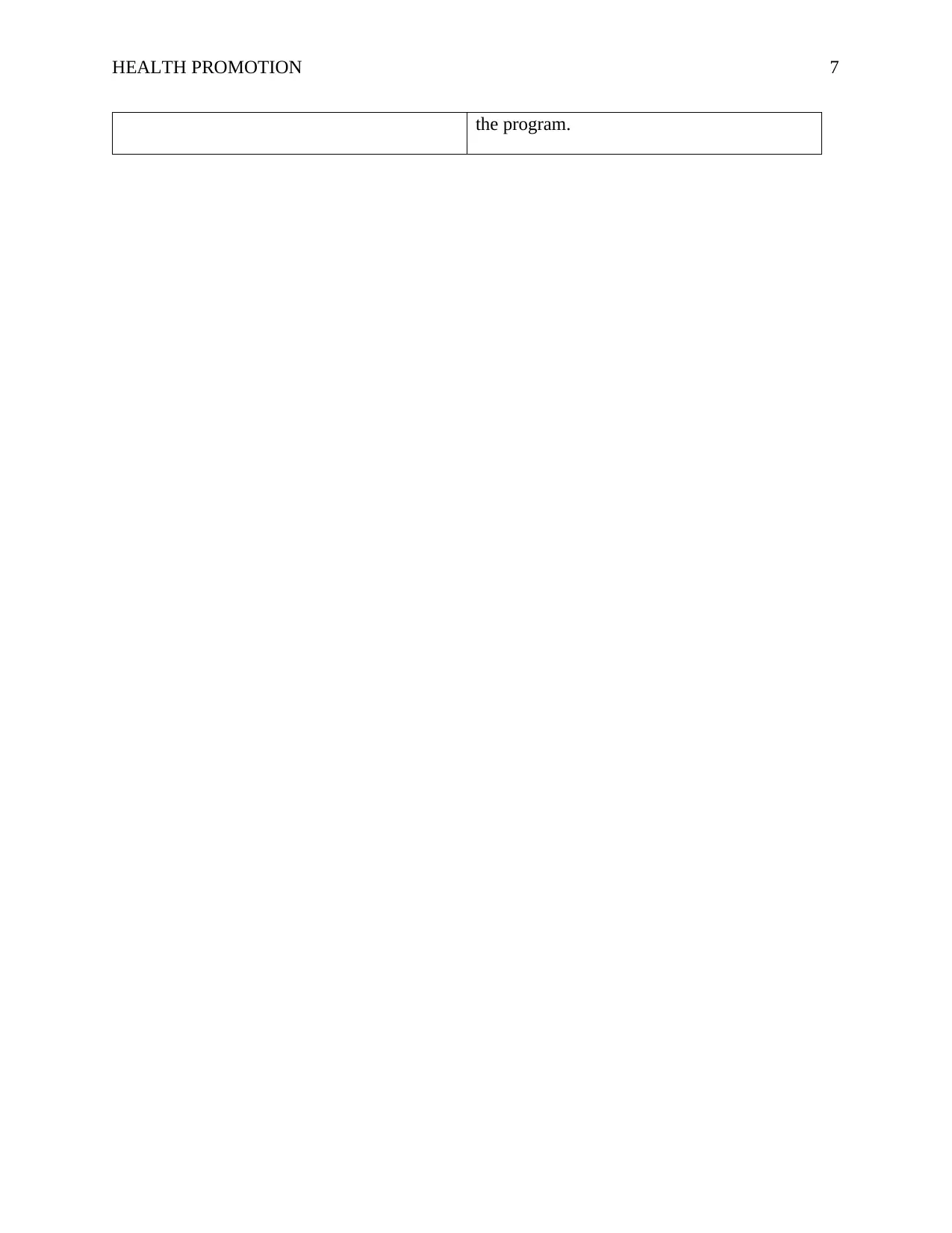
HEALTH PROMOTION 7
the program.
the program.
Paraphrase This Document
Need a fresh take? Get an instant paraphrase of this document with our AI Paraphraser
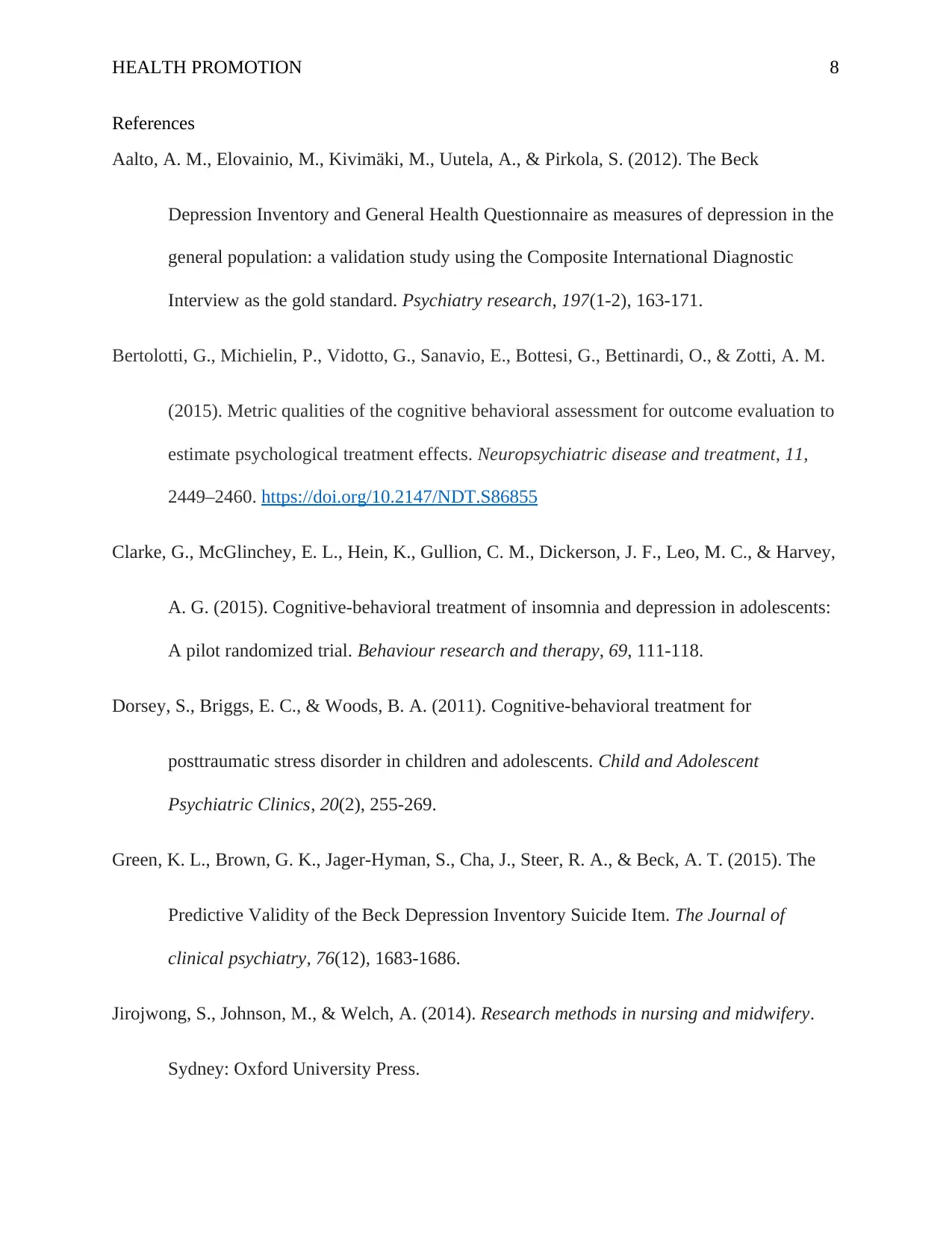
HEALTH PROMOTION 8
References
Aalto, A. M., Elovainio, M., Kivimäki, M., Uutela, A., & Pirkola, S. (2012). The Beck
Depression Inventory and General Health Questionnaire as measures of depression in the
general population: a validation study using the Composite International Diagnostic
Interview as the gold standard. Psychiatry research, 197(1-2), 163-171.
Bertolotti, G., Michielin, P., Vidotto, G., Sanavio, E., Bottesi, G., Bettinardi, O., & Zotti, A. M.
(2015). Metric qualities of the cognitive behavioral assessment for outcome evaluation to
estimate psychological treatment effects. Neuropsychiatric disease and treatment, 11,
2449–2460. https://doi.org/10.2147/NDT.S86855
Clarke, G., McGlinchey, E. L., Hein, K., Gullion, C. M., Dickerson, J. F., Leo, M. C., & Harvey,
A. G. (2015). Cognitive-behavioral treatment of insomnia and depression in adolescents:
A pilot randomized trial. Behaviour research and therapy, 69, 111-118.
Dorsey, S., Briggs, E. C., & Woods, B. A. (2011). Cognitive-behavioral treatment for
posttraumatic stress disorder in children and adolescents. Child and Adolescent
Psychiatric Clinics, 20(2), 255-269.
Green, K. L., Brown, G. K., Jager-Hyman, S., Cha, J., Steer, R. A., & Beck, A. T. (2015). The
Predictive Validity of the Beck Depression Inventory Suicide Item. The Journal of
clinical psychiatry, 76(12), 1683-1686.
Jirojwong, S., Johnson, M., & Welch, A. (2014). Research methods in nursing and midwifery.
Sydney: Oxford University Press.
References
Aalto, A. M., Elovainio, M., Kivimäki, M., Uutela, A., & Pirkola, S. (2012). The Beck
Depression Inventory and General Health Questionnaire as measures of depression in the
general population: a validation study using the Composite International Diagnostic
Interview as the gold standard. Psychiatry research, 197(1-2), 163-171.
Bertolotti, G., Michielin, P., Vidotto, G., Sanavio, E., Bottesi, G., Bettinardi, O., & Zotti, A. M.
(2015). Metric qualities of the cognitive behavioral assessment for outcome evaluation to
estimate psychological treatment effects. Neuropsychiatric disease and treatment, 11,
2449–2460. https://doi.org/10.2147/NDT.S86855
Clarke, G., McGlinchey, E. L., Hein, K., Gullion, C. M., Dickerson, J. F., Leo, M. C., & Harvey,
A. G. (2015). Cognitive-behavioral treatment of insomnia and depression in adolescents:
A pilot randomized trial. Behaviour research and therapy, 69, 111-118.
Dorsey, S., Briggs, E. C., & Woods, B. A. (2011). Cognitive-behavioral treatment for
posttraumatic stress disorder in children and adolescents. Child and Adolescent
Psychiatric Clinics, 20(2), 255-269.
Green, K. L., Brown, G. K., Jager-Hyman, S., Cha, J., Steer, R. A., & Beck, A. T. (2015). The
Predictive Validity of the Beck Depression Inventory Suicide Item. The Journal of
clinical psychiatry, 76(12), 1683-1686.
Jirojwong, S., Johnson, M., & Welch, A. (2014). Research methods in nursing and midwifery.
Sydney: Oxford University Press.
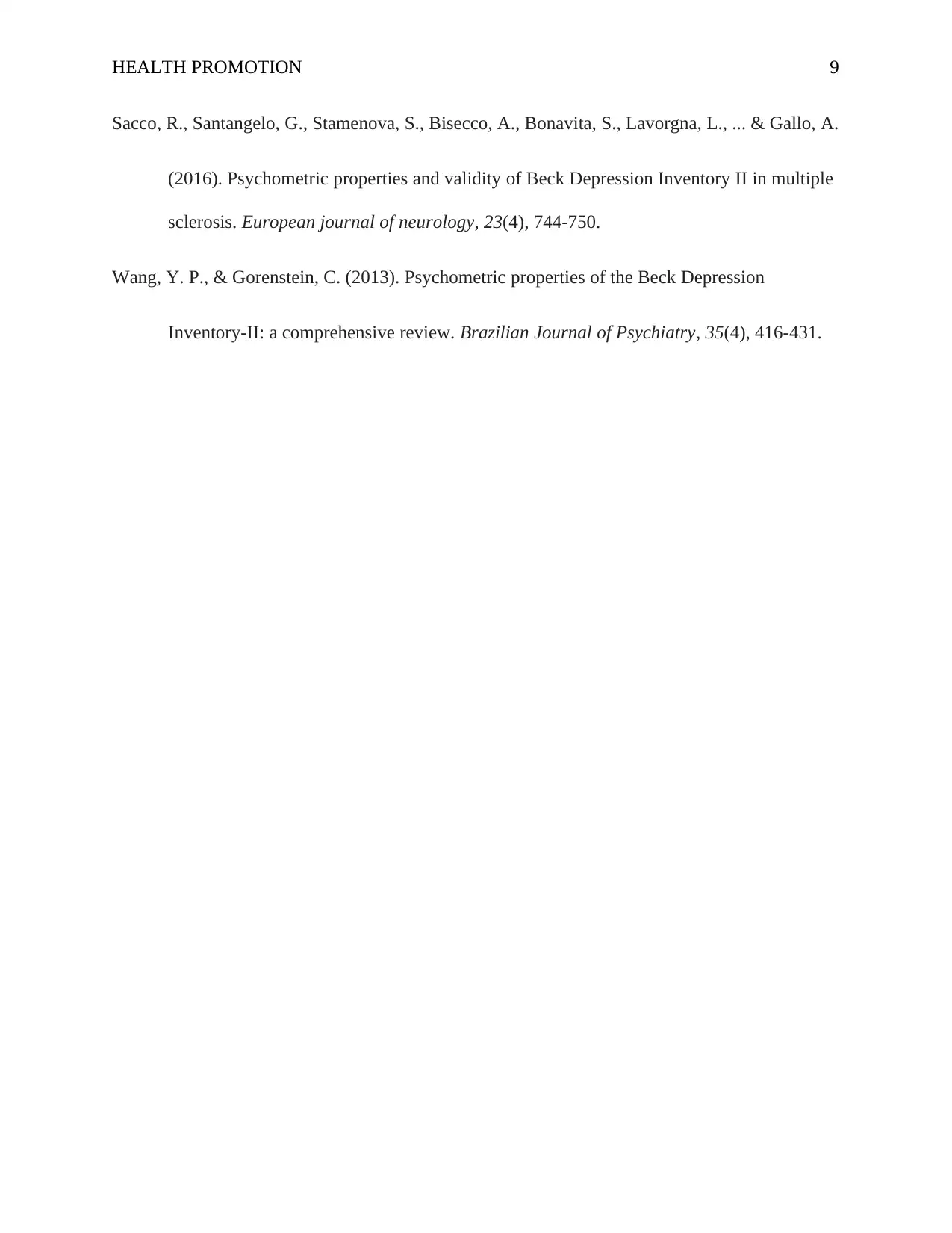
HEALTH PROMOTION 9
Sacco, R., Santangelo, G., Stamenova, S., Bisecco, A., Bonavita, S., Lavorgna, L., ... & Gallo, A.
(2016). Psychometric properties and validity of Beck Depression Inventory II in multiple
sclerosis. European journal of neurology, 23(4), 744-750.
Wang, Y. P., & Gorenstein, C. (2013). Psychometric properties of the Beck Depression
Inventory-II: a comprehensive review. Brazilian Journal of Psychiatry, 35(4), 416-431.
Sacco, R., Santangelo, G., Stamenova, S., Bisecco, A., Bonavita, S., Lavorgna, L., ... & Gallo, A.
(2016). Psychometric properties and validity of Beck Depression Inventory II in multiple
sclerosis. European journal of neurology, 23(4), 744-750.
Wang, Y. P., & Gorenstein, C. (2013). Psychometric properties of the Beck Depression
Inventory-II: a comprehensive review. Brazilian Journal of Psychiatry, 35(4), 416-431.
⊘ This is a preview!⊘
Do you want full access?
Subscribe today to unlock all pages.

Trusted by 1+ million students worldwide
1 out of 9
Related Documents
Your All-in-One AI-Powered Toolkit for Academic Success.
+13062052269
info@desklib.com
Available 24*7 on WhatsApp / Email
![[object Object]](/_next/static/media/star-bottom.7253800d.svg)
Unlock your academic potential
Copyright © 2020–2025 A2Z Services. All Rights Reserved. Developed and managed by ZUCOL.





